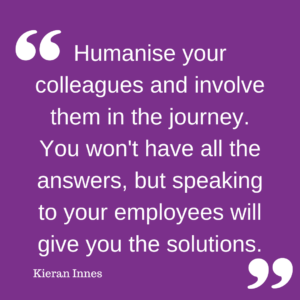The latest session on the Contact Centre Network featured an insightful discussion on employee engagement with two distinguished speakers: Kieran Innes from Stribe and Jo Garland Experienced Contact Centre Operational leader. The session focused on strategies to enhance employee engagement, particularly in hybrid and remote work environments.
According to findings from a poll by recruitment firm Robert Walters in August 22, which surveyed 2,000 white collar professionals, the UK could be facing a ‘disengagement crisis’ as almost half of employees said their workplace had become unrecognisable in the past 12 months – with high staff turnover (54 per cent), fewer people working from the office (49 per cent) and a decline in team socials (43 per cent) being the main reasons cited.
Here we discussed if this was still accurate are below are the key themes and takeaways from the conversation, enriched with Jo Garland’s research findings on employee engagement which was conducted during COVID when many contact centres were mandated to work from home. The research aimed to identify elements of the employee experience that drive or detract from engagement, using a blend of qualitative interviews with various teams and tenures were used to gather insights, the key themes that were evident:
.Role Characteristics:
- Variety and Challenge: Roles with a higher degree of variety and challenge were key drivers of engagement.
- Task Monotony: Monotonous tasks were significant demotivators.
- During COVID, employees took on diverse tasks like virtual training, which increased engagement.
- For leaders, an appropriate level of challenge was crucial; too much challenge could lead to disengagement.
Leadership:
- Support and Autonomy: Effective leaders provide support and enable autonomy, allowing employees to make decisions.
- Remote work increased decision-making confidence as employees had to operate more independently.
- Leadership is critical in creating an environment conducive to engagement, especially in remote settings.
Team Dynamics:
- Sense of Belonging: A strong sense of belonging within the team was essential for engagement.
- Perceived Equality: Ensuring all team members were treated equally was crucial.
- Daily professional and personal interactions among team members enhanced engagement.
Communication:
- Customer Interaction: Positive customer interactions boosted engagement, especially when employees could solve problems.
- Technology and Tools: Use of webcams and other technology to maintain communication was important during remote work.
- Employee Voice: Having multiple channels for employees to voice their opinions and ensuring actions were taken based on feedback was a key driver of engagement.
Importance of Leadership in Remote Environments
- Leadership is pivotal in remote work environments to ensure role variety, challenge, and the right team dynamics.
- Leaders must create an environment that supports engagement through effective communication, recognition, and promoting a sense of belonging.
During the session we we delved into each of these areas in some detail with both Kieran and Jo and below we share some of the detailed examples and stories that each of the panel shared to bring the topic to life we hope you enjoy and take some insight from the points raised.
 The Importance of Leadership in Employee Engagement
The Importance of Leadership in Employee Engagement
One of the central themes was the critical role of leadership in fostering an engaged workforce. Jo Garland emphasised, “The capability of the team leader in providing support and opportunities is crucial in driving engagement.” Effective leadership involves creating a supportive environment where employees feel valued and motivated. Jo’s research highlighted that leaders must provide pastoral support and delegate appropriately to enable autonomy. The panel highlighted how the Team leaders role has the capacity to influence the emotions of the team both positively and negatively based on how they show up for the day, with their spans of control sometimes reaching 15 or 16 if they show up with a “Bad Day” the team members immediately recognise this and its sets the tone for the day “Don’t approach them, they’re in a bad mood” – This means your team are less likely to ask for help and support and if this is a constant it can leave the team with a gap and disengagement ensues. It’s important as leaders we check our own emotions and recognise our own triggers and open with the team on how you are feeling. This requires leaders to be human and show some vulnerability which leads nicely to our discussion point on the role of Psychological safety.

Psychological Safety and Trust
In order to have really engaged teams they need to feel comfortable. raising issues and having open and meaningful dialogue with leaders across all levels. team need to feel they can bring ideas and suggestions to the table without being judged or made to feel stupid. Team members need to be able to feel they can constructively challenge things that may go against their values or belief systems without a fear of reprisal. team members in order to be fully engaged need the right level of support and comfort that asking for support won’t be seen as weakness. This is what we refer to as high levels of psychological safety. Both speakers underscored the importance of psychological safety and trust in the workplace. Kieran noted, “If people don’t feel like they can speak up, they just won’t.” Creating a safe space for employees to voice their concerns and ideas without fear of reprisal is essential for innovation and collaboration. Jo’s research confirmed that a trusting environment enhances decision-making and overall job satisfaction.
Humanising Colleagues
Kieran highlighted the need to humanise colleagues, this was about sharing a part of your personally that other people may not readily be aware of , building some personal connections with your team so they understand who they are working with on a deeper level and can build some common ground and connection with. This is especially important in remote settings. He shared practical ideas like virtual team-building activities, shared playlists, and personal check-ins. “It’s important to create personal connections with colleagues to foster a sense of belonging,” he said. Jo’s research also pointed out that building personal connections enhances team dynamics and a sense of belonging. There were some great examples where Keiran suggested activities like, bring your dog to work day and spending just 5 or 10 minutes at the start of virtual meetings as an open discussion about no work related topics, important point here is to allow the teams to bond with other, both virtually and face to face to build a sense of team identity, common ground and a feeling of belonging.
Balancing Autonomy and Support
People thrive when they feel connected to a wider purpose for an organisation, but they also enjoy not being micromanaged and having the ability to get on with there work without feeling that they are constantly being watched and monitored. Within the contact centre industry this can feel more of a challenge given how metric and productivity driven the industry is. Jo’s research identified the balance between autonomy and support as a key driver of engagement. She advised leaders to “know where to support and where to delegate” and to challenge processes that hinder employee autonomy. This balance helps employees feel empowered and trusted in their roles. Jo’s findings emphasised the importance of role characteristics, variety, and challenge in maintaining engagement. Creating variety in roles helps people feel more stimulated, as repetition can lead to boredom quite quickly, inviting the thoughts of the team on what they could do differently and how they could flex their strengths in other areas can lead to really positive feeling of inclusion, ideation and higher levels of engagement.
Addressing Burnout and Stress
We know that the contact centre industry with it’s high contact volumes and demand levels can be stressful and can lead to burnout, understanding your teams levels of resilience, workloads and reactions to stressful situations means getting to know your teams better and helping them recognise their triggers for stress and burnout. This is achieved through regular communication and inviting questions about how they are feeling, how they are coping with workloads and understanding the nature of the conversation and interactions they are dealing with and empowering them to be able to flag to you when they need to “take 5” . stablishing clear lines of responsibility and autonomy to do this can be useful and understanding where your teams non negotiables are to allow them the capacity to unplug is critical. As leaders we need to help teams connect with more wellbeing activities available internally and support them to balance work and life. Both speakers recognised the growing issue of burnout and stress in contact centres. Jo suggested that providing more control and autonomy to employees can mitigate stress. Kieran added that promoting wellness programs and encouraging their use without stigma is crucial. “Leaders need to show that they care and model healthy work behaviours.” Jo’s research found that role overload and lack of support significantly contribute to disengagement so as leaders we need to review capacity and establish the appropriate levels of support for each individual be tailoring the conversation to each of your teams needs.
Effective Communication

Combating Bricks and Mortar Bias
As we transition from fully remote to hybrid and for some contact centres move fully back to the physical office environment 100% we start to see some different dynamics surface from those that work in the office some of the time versus those that work fully remote. This leads to a discussion around the feelings from team members of a “bricks and mortar bias,” this is where remote employees feel disconnected from their in-office counterparts. This can lead to a feeling that those in the office environment are treated more favourably and that opportunities may be given to those in the constant line of site of leaders onsite and that out of sight may actually mean out of mind and they may be overlooked and undervalued because they aren’t on site, which can lead to a stronger sense of disconnection and impacts that feeling of belonging that Jo talked about in her research. Both speakers suggested solutions like ensuring equal participation in meetings and being mindful of the diverse needs of remote workers. Jo’s research highlighted the importance of perceived equality and team dynamics in fostering a sense of community. Having employee charters and ways of working outlined can help combat this and be open and transparent with job opportunities and inviting career discussion and asking people how they are feeling about the team dynamic and connections with other can help bring out these discussion points and concerns.
Addressing the Challenges of Hybrid and Remote Work Environments
Equal Participation and Communication: One of the significant challenges in hybrid and remote work environments is ensuring that all employees feel equally included and valued. Jo emphasised the importance of creating opportunities for remote employees to participate equally in meetings and collaborative sessions. She suggested practical steps such as having all participants join important meetings remotely, even if some are physically present in the office. This approach helps eliminate the imbalance that can occur when some team members are together in a room while others are dialled in.
Shared Purpose and Personal Connections: To build a sense of community among remote and hybrid teams, Jo and Kieran highlighted the necessity of fostering a shared purpose and creating opportunities for personal connections. Jo suggested daily check-ins that align team goals and encourage personal interaction. “Checking in at the start of a meeting with a word about how you’re feeling today can build those personal connections,” she said. These interactions help employees feel more connected to their team and the organisation.
 Recognition and Celebration: Kieran emphasised the role of recognition in bridging the gap between remote and in-office employees. He recommended celebrating behaviours and achievements visibly across the organisation. “Recognising employees publicly, whether through newsletters or virtual all-hands meetings, can help integrate remote workers into the organisational culture,” he said. Jo’s research also supported this, noting that recognition and a sense of belonging are crucial for engagement.
Recognition and Celebration: Kieran emphasised the role of recognition in bridging the gap between remote and in-office employees. He recommended celebrating behaviours and achievements visibly across the organisation. “Recognising employees publicly, whether through newsletters or virtual all-hands meetings, can help integrate remote workers into the organisational culture,” he said. Jo’s research also supported this, noting that recognition and a sense of belonging are crucial for engagement.
Leveraging Technology: Technology plays a pivotal role in connecting remote and hybrid teams. Kieran shared how Stribe utilises various tools to maintain communication and collaboration. “We use tools like shared digital canvases and Slack channels to ensure everyone is on the same page, regardless of location,” he explained. Ensuring that all employees have access to and are proficient in these tools is vital for maintaining effective communication and collaboration.
Flexible and Inclusive Work Policies: Both speakers agreed on the importance of flexible work policies that cater to individual preferences and needs. Jo pointed out that recognising individual preferences for work locations and schedules can significantly impact engagement. “It’s about making sure everyone feels connected and valued, whether they’re in the office or working from home,” she said. This approach helps mitigate the risk of employees feeling isolated or overlooked due to their work arrangements.
Conclusion
By focusing on leadership, psychological safety, communication, and balancing autonomy with support, organisations can create a more engaged and motivated workforce. As Kieran aptly put it, “We want to make every Monday feel like Friday.”
For those looking to dive deeper into the topic, the next session in September will focus on performance management practices and coaching in contact centres. Stay tuned for more insights and strategies to improve your contact centre operations.

